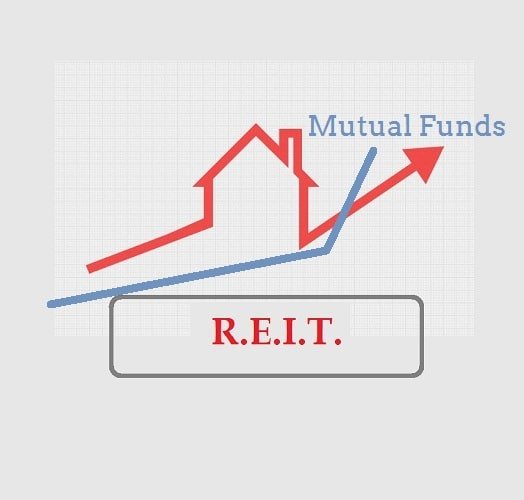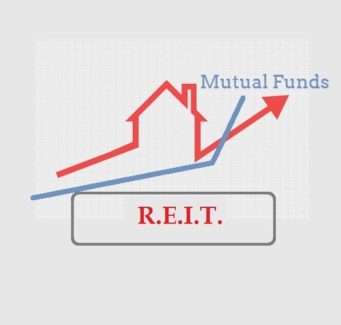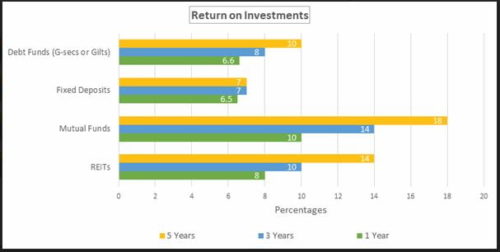
~The pros, cons and ho-hums about Indian REITs as they stand now~

Shobhit Agarwal, MD & CEO – ANAROCK Capital
REITs are finally happening in India, and that’s good news. While real estate as an asset class has always attracted both small and big investors, other investment instruments – gold, stock markets, fixed deposits, mutual funds etc. – have also been a part of well-diversified investment portfolios.
However, most of these asset classes have come with not-inconsiderable risks in recent times. The value of gold has eroded visibly, mutual funds have responded sharply to the recent stock market downturns, and fixed deposit returns barely break even after taxation.
Investors are looking for investment avenues that provide them steady income with minimal risks and under professional management, ultimately ensuring decent return on investments. It can safely be stated that REITs could not have made their appearance in India at a more opportune time.
Investment in commercial real estate is a highly capital-intensive affair. REITs are a very viable option addition to investment portfolios because they allow investors to participate in an asset class previously reserved only for the affluent few. Also, as is the case in developed nations, REITs provide very decent returns with minimal risks.
How REITs will Benefit Small Investors
Let’s look at what we have at the current time. The Blackstone-backed Embassy Group includes the income-generating SEZ and IT parks under its first REITs listing – potentially a highly lucrative proposition for small as well as big investors to get involved in.
Today, commercial real estate is doing exceptionally well in India, thanks to the aggressive expansion plans of both local and global businesses. Like mutual funds did for the stock market, REITs open a door to a potential treasure trove of returns to small investors – minus the downside of market downturns.
Stable rent-yielding Grade A commercial properties are high in demand with rentals seeing a steady increase. In sharp juxtaposition to the extremely volatile stock markets, Grade A office rentals will increase regardless of whether supply increases or decreases. There just isn’t enough supply to meet all the demand for this type of real estate, because the locations that qualify Grade A office assets have limited growth capacities.
In short, demand will always outstrip supply – and as long as this remains so, returns from REITs can only be in the green. They are far less prone to risks and will deliver decent returns over the short-to-mid-term.
Some of REITs’ USPs
REITs offer various advantages to investors:
- A low entry point – as low as Rs. 2 lakh – effectively means that one can add real estate to one’s portfolio at a much lower investment.
- The projected return on investments are anywhere between 8-14% in the short-to-medium term (post adjustment of the fund management fee), with minimum risks. REITs are far less volatile than the stock market, FDs, mutual funds and gold because regulations maintain that 80% of the REITs listings must be of rent-generating assets.
- A lot of institutional capital is chasing the limited supply of investible Grade A office stock across top property markets. Therefore, the rents for these listed properties are very likely to rise steadily, and the contractual terms will be far more structured and transparent.
- REITs guidelines maintain that at least 90% of the net distributable income after tax will be distributed to investors at least twice a year.
US, Canada, UK, Singapore and Australia are some of the countries with dynamic and flexible REITs markets that have proved to be highly lucrative for investors. For instance, in Canada, the average return was around 10% in 2017, while in the UK it hovered between 8-10%. The average return in these countries includes all REITable assets such as commercial and residential.
In India, REITs have currently been limited to commercial Grade A office spaces – however, the umbrella of ‘commercial spaces’ also covers retail. In other words, investors of varying investment appetites and capacities will actually be sharing in the profits of India’s best shopping malls.
Expected ROI – REITs vs other asset classes

On the Flipside
The success of REITs in India will largely depend on the benefits they offer to investors. Currently, there are a plethora of taxes that may make REITs unattractive for many. For instance, when a REIT sells shares of assets, the capital gains are taxable.
In contrast, in UK where REITs have been operating for over a decade now, there is no taxation on income and gains from their property rental business. Instead, shareholders are taxed on REIT-related property income when it is distributed, and some investors may even be exempt from tax altogether.
Further, in other countries there have been exemptions from the stamp duty, as well. If and when India provides these tax benefits to investors, REITs will become all the more functional and lucrative in the long run. Also, if REITs are made more attractive for investors with such tax sops, the flood-gates of foreign funding into Indian real estate will open up in real earnest.
The Immediate Future
It will indeed be interesting to see the response to the first REIT listings in India. We do need to remember that, as is the case with any kind of real estate investment, the degree of their success depends heavily on a favourable macroeconomic environment backed by sound policy reforms.
To make the most of REITs in India and earn maximum returns, analyze the portfolio of projects included under the REIT. The analysis must include the stature and historic track record of the concerned entity, the developers’ portfolio, and the location advantages of the properties – including micro market, IT Parks, and so on.
Effectively, a REIT will drive price appreciation at the lowest risk if it includes Grade A commercial spaces with minimal vacancy, located in the best business-centric micro markets, with established rentals and occupiers.
(Disclaimer – The views and opinions expressed in this article are those of the author’s and do not necessarily reflect the official policy or position of www.estrade.in. For further queries kindly feel free to write info@estrade.in)
REITs – Realty Gold Over Stock Market Blues?





